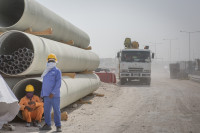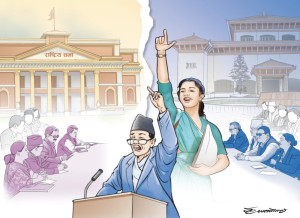Columns
Paradoxes in higher education
Three constraints are particularly evident in reforming Nepal's higher education system.
Achyut Wagle
A recent statistic reveals that during the first three months of this year, about 40,000 students obtained no objection certificates from the Ministry of Education for university studies abroad. Students need the certificate to get foreign exchange to pay their tuition, travel and accommodation costs. Even if only accounted for in official figures, about $300 million flew away with them at a time when Nepal reels under the duress of rapidly dwindling foreign currency reserves. At this rate, the number of students flying out of the country are likely to cross 100,000 this year alone.
Credible and comprehensive data on the exact number of students leaving the country for higher studies and the amount that bleeds out of national exchequer is extremely scanty. Conservative estimates assume that some 60-75,000 students fly out of the country each year, mainly to the developed countries, and at least $1.5 billion flies out with them. Almost an equal amount is suspected to flow out informally. The ministry's statistics show that till the last fiscal year, about 400,000 students went for studies abroad during the period of the last one decade. This trend has only grown over the years, and after the lifting of Covid-19 related restrictions by major destination countries like Australia, the UK, Japan, the US and others, the growth has been geometric.
The paradoxes
The demand-supply paradox in Nepal's higher education is precariously manifested by such an incessant outflow of students, and foreign currency, while higher education institutions across the board are even unable to fill the approved seats for admission. Students are going to foreign countries not only for highly technical and scientific courses like artificial intelligence, astronomy, biochemical engineering or nuclear science, but also for regular humanities and social science courses.
The reason for such an exodus is generally touted as the "unacceptable" quality of the educational outcome of Nepali institutions. In essence, this phenomenon has put both the very future of Nepal's higher education and billions of dollars in private investments in the sector in jeopardy. Nepal's higher education institutions, including 12 universities and hundreds of their affiliates, educationists and policymakers appear unarmed to defend this persistently ominous allegation. This, implicitly, connotes that our national system of higher education has indeed failed to meet national expectations.
Apart from the students leaving the country in hordes, Nepali education institutions are also feeling the heat of increased market competition on several fronts. Private colleges here are operating with affiliation from international universities and many reputed international institutions themselves are vying to open campuses in Nepal. Also, there are clear indications that after India adopted its National Education Policy 2020 with one of the key priorities as "internationalisation" of Indian education, several Indian educational institutions are planning to be physically present in the Nepali market, further exacerbating the competition.
Needless to say, in terms of poor outcomes as against huge public investments, state-funded universities have largely failed the nation. Self-funded public universities like Kathmandu University, despite its undisputed best performance over the years, are deprived of adequate resource support from public funds to sustain the quality and expand its programmes. Other things apart, such state policy would have stopped at least a few thousand students from going abroad each year. The colleges are unable to admit the given quota of students due to extremely conservative policy approaches like in admission to medical education. For example, the Nepal Medical Commission, last year, didn't even pass an adequate number of students through the entrance test so medical colleges could fill their approved seats. Higher education has attracted substantial private investment. But their quality was implausible to expect to surpass the average of their respective parent university. This is a clear pitfall of Nepal's inability to come out of the infamous "licence regime" in education where inefficient "licensing" authorities still hold sway.
While viewing things from an ecosystem approach, quality doesn't seem to be the sole reason for students wanting to leave the country. It is perhaps more due to lack of credible mechanisms to obtain financial support, including easy loans, to attain higher education coupled with the absence of post-education employment surety. The problem thus is also correlated with the domestic job market structure.
The bottlenecks
Three constraining bottlenecks are particularly evident in reforming Nepal's higher education system. First, policy reform is very tardy. The policymaking leadership, both political and administrative, has constantly failed to comprehend the fast-changing paradigms of education as well as the dynamics of the future job market. Continuous reform in the curricula and pedagogy often takes a back seat. The delivery of even predesigned courses has ubiquitously remained sub-optimal. The idea of linking academic output with the potential demand for skills in the job market is hardly imbibed in the policymaking process.
Second, the availability of a well-qualified faculty remains another daunting challenge. Teaching in Nepal is a relatively low-paying and under-revered profession. It does not attract top-ranking graduates. Most of the teachers hired are thus mediocre and leftovers from more attractive jobs outside academia. An undersupply of training and faculty development opportunities is having telling adverse effects on quality.
Third, Nepal's education system has historically suffered from chronic underinvestment. The government budget for the current fiscal year has allocated Rs180 billion for the sector which constitutes only about 4.2 percent of the GDP. This is fairly low even compared to developing country practices. Besides, the proper utilisation of the allocated funds vis-à-vis the educational outcomes is also pathetic, to say the least.
Things were expected to substantially improve after the promulgation of the federal constitution that categorically separated the responsibilities of imparting school education to the local level, and higher education to the federal and provincial levels. But successive governments during the last seven years have failed to bring out the required legislation to regulate university education. The much awaited "umbrella bill on higher education" is still hanging in limbo. Clearly, there appears to be an absence of political will to improve the country's higher education without which the downhill journey is impossible to avert.




 12.12°C Kathmandu
12.12°C Kathmandu













%20(1).jpg&w=300&height=200)

